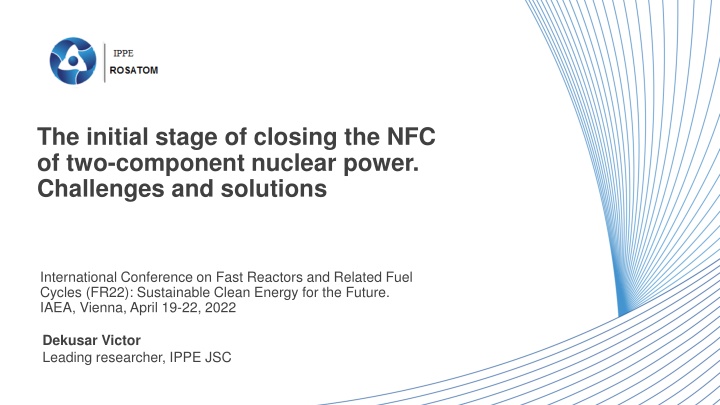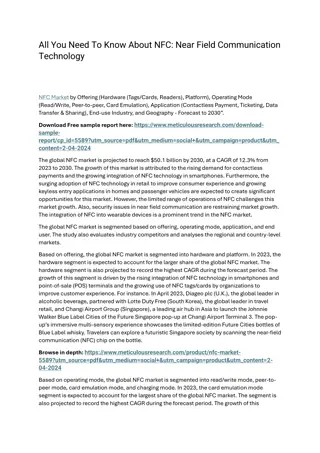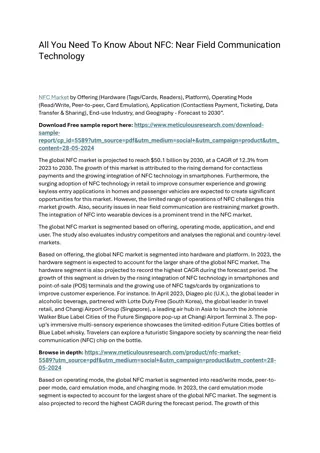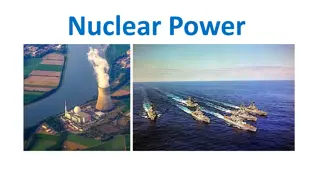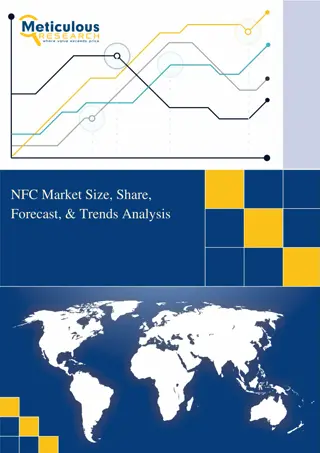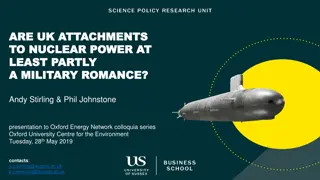Challenges and Solutions in Closing the NFC of Two-Component Nuclear Power
Strategic goal of transitioning Russian nuclear power plants to a two-component NES, focusing on the initial stage of closing the NFC. Scenario involves thermal neutron reactors with fuel cycle closure using BN reactors. Analysis shows the feasibility of using existing plutonium stockpiles for future fast reactor fuel needs, optimizing costs and efficiency.
Download Presentation

Please find below an Image/Link to download the presentation.
The content on the website is provided AS IS for your information and personal use only. It may not be sold, licensed, or shared on other websites without obtaining consent from the author.If you encounter any issues during the download, it is possible that the publisher has removed the file from their server.
You are allowed to download the files provided on this website for personal or commercial use, subject to the condition that they are used lawfully. All files are the property of their respective owners.
The content on the website is provided AS IS for your information and personal use only. It may not be sold, licensed, or shared on other websites without obtaining consent from the author.
E N D
Presentation Transcript
The initial stage of closing the NFC of two-component nuclear power. Challenges and solutions International Conference on Fast Reactors and Related Fuel Cycles (FR22): Sustainable Clean Energy for the Future. IAEA, Vienna, April 19-22, 2022 Dekusar Victor Leading researcher, IPPE JSC
Introduction The transfer of Russian nuclear power plants to the regime of a two-component NES with thermal and fast reactors in a single closed nuclear fuel cycle is the strategic goal of the State Corporation ROSATOM for the coming decades. Reasonable planning of the initial stage of closing the NFC is the most difficult and crucial moment (technological and economic uncertainties). When choosing the scenario for the initial stage of closing the NFC, one of the main criteria is the criterion of minimal capital costs. 2
Scenario. Reactors A feasibility study was carried out for commissioning scenarios for the head unit and a small series of fast neutron reactors. The chosen scenario is an innovative development of the existing nuclear power system mainly with thermal neutron reactors with fuel cycle closure using BN reactors. The following reactors were considered: BN-800, high-power BN type (BR = 1.2) with MOX fuel, a variant with an axial interlayer and with an average fuel burnup of about 13%. By 2050, up to 6 high-power commercial reactors of the BN type will be commissioned. SNF from all thermal reactors, except for RBMK-1000, is reprocessed and all plutonium is used to make MOX fuel assemblies for BN-800 and high-power BN reactors. SNF from all thermal reactors, except for RBMK-1000, is reprocessed and all plutonium is used to make MOX fuel assemblies for BN-800 and high-power BN reactors. 3
Scenario. Fuel material flows Installed capacity of 91 GW by 2100. Complete disposal of VVER SNF by 2050. Volume of separated plutonium ~ 100 t operating reserve for loading and new reactors. Remaining plutonium in SNF 2100g ~ 900 t. Consumption of natural uranium in NES is about 520 thousand tons. Utilization of plutonium residue together with reprocessed VVER SNF makes it possible to develop the installed capacity of the project up to ~ 120 GW by 2130. An additional ~5 GW can be obtained by using uranium regenerate in thermal reactors. 4
Analysis of demands for fast reactor fuel An analysis of the current state of plutonium stockpiles (about 60 tons) and the results of fuel cycle modeling showed a significant amount of plutonium available in the SNF of thermal reactors by the time the head commercial high-power reactor of the BN type was commissioned. The amount of plutonium is sufficient to start up and continue the operation of the head unit until the end of its design life (60 years). Moreover, this plutonium is also enough to start up several more serial BN reactors. In this regard, it is expedient to consider the scenario of the initial stage of the transition to a two- component NES with deferred reprocessing of MOX SNF from fast reactors for the period after 2040. Refusal from immediate reprocessing of SNF from the head and first serial BN reactors leads to the abandonment of capital expenditures for low-tonnage, economically inefficient production for reprocessing SNF from BN, and, accordingly, to a significant reduction in the annual fuel costs of nuclear power plants. An acceptable number of power units, at which a significant (about 2 times) reduction in the unit cost of processing is achieved, is the number of 6-9 power units of high-power fast reactor (type BN). 5
Radial blanket. Fuel reprocessing specific costs In addition, in conditions of a sufficient amount of plutonium at the initial stage, it is possible to abandon the radial blanket , temporarily replacing it with steel. In this case, the costs of its manufacture and processing are excluded. Specific cost of spent nuclear fuel reprocessing depending on the productivity of the plant 6
Fuel Cost, US$/Wh (10-3US$/kWh) With reproducing blanket With steel blanket Stages of the fuel cycle Front-End Core FA fabrication Radial blanket FA fabrication Fresh core FA transportation to NPP Fresh radial blanket transportation to NPP Total for Front-End 5.13 0.21 0.14 0.07 5.56 5.13 - 0.14 - 5.27 Back-End Core SFA transportation to reprocessing Radial blanket SFA transportation to reprocessing Core FA intermediate storage Radial blanket SFA intermediate storage Core SFA reprocessing Radial blanket SFA reprocessing Final radioactive waste isolation Total for Back-End 0.09 0.04 0.01 0.01 0.67 0.30 0.10 1.22 0.09 - 0.01 - - - - 0.10 Full fuel cost 7 Full fuel cost 6.78 5.37
Economic benefits Abandonment of reprocessing BN SNF at the initial stage of the NFC closure, as well as of the radial reproducing blanket, results in a decrease in FCC from 0.68 /kWh to 0.54 /kWh, or by 26%, with the vast majority (21%) of the decrease due precisely to refusal of SNF processing. Considering that the fuel cost component for fast reactors is usually about 15-20% of the total cost, we find that the rejection of spent nuclear fuel reprocessing leads to a decrease in the total cost by approximately 4-5%. 8
Conclusion By the time a high-power BN-type reactor is put into operation (after 2030), the Russian NP will have a sufficient amount of separated plutonium from SNF of thermal reactors. Reprocessing of fast reactor SNF to plutonium separate will be required only after 2050. Due to a noticeable increase in fast reactor NP by this time, one should expect a significant decrease in the specific costs of SNF reprocessing. Refusal of fast reactor SNF reprocessing at the initial stage of the transition to a two-component nuclear power system results in a significant improvement in economic indicators. 9
Thank you for the attention Dekusar Victor Leading researcher, IPPE JSC l.: +7 (484) 399 86 22 E-mail: decouss@ippe.ru 2022
